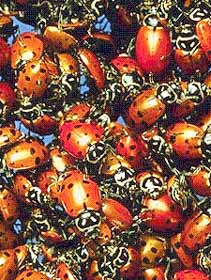
I wish I knew more about ladybugs. They are such inoffensive little critters, yet do so much good for us gardeners. As a child, I was taught that they were one of the "good bugs," and I've always gone out of my way to protect both the adults and the dragonlike larvae.
So you can appreciate my mixed feelings when, on a singularly warm day in early November 1994, the entire south wall of my clapboard farmhouse was covered with a swarm of ladybugs, seemingly hundreds of them. While I was delighted at their antics and numbers, I couldn't open a door without admitting them into our home, where they collected on sun-warmed walls and windows. If you've ever tried to catch a single ladybug (or a married one, for that matter!), you know how they scuttle around and fly at the lightest touch. Just imagine trying to evict dozens of ladybugs!
I thought we had been uniquely blessed until I began inquiring and discovered that homeowners all over my upstate area of South Carolina had seen or experienced the same phenomenon, on about the same day. Thanks to continuing unusually mild weather, the ladybugs hung around for a couple of weeks before, I assume, going back to their hidey-holes beneath stones and decaying logs. Frankly, I missed the little fellers ... until they began to reappear in my bathroom during the depth of winter. I was able to return most of them to the great outdoors, but some expired belly up, much to my chagrin.
I knew that several species of ladybugs, both native and imported from Australia for controlling cottony-cushion scale, can be found in various parts of the United States. I convinced one of the ladybugs to hold still long enough to count its spots and found 18. Then on to my ancient reference book, Dr. Cynthia Wescott's The Gardener's Bug Book (Fourth Edition), only to find that they are not ladybugs but lady beetles!
Well, I can understand the reasoning. True bugs are little suckers with flattened, shield-shaped bodies and long bills -- squash bugs, chinch bugs, harlequin bugs, and such -- mostly bad guys. Beetles can be round or elongated, and can be winged or flightless, but have hard shells and include more good guys than bad.
Wescott's volume topped out at 13 spots, leaving me in the dark about the habits of my 18-spotted friends. However, I always try to have an ace in the hole. When it comes to bugs (Oops! Beetles!), mine is an entomologist at Clemson University: Professor Randall P. Griffin. He identified the 18-spotted lady beetle as an introduced species, Harmonia axyridis.
"We hadn't heard much about this species until the fall of 1994," said Griffin, "when the switchboards at the various Extension offices around the South, West, and Northwest lit up like Christmas lights. The horticultural agent at Greenwood, South Carolina, called me at the time of your outbreak, and he had three calls from homeowners on hold, all phoning about the lady beetle invasion. I even received a fax from a colleague in Oregon describing large aggregations of Harmonia axyridis occurring in western Oregon in 1993 as well as in 1994 and asking if it had been seen on Christmas tree farms in the Carolinas."
Griffin explained that the large gatherings of this introduced lady beetle were due to their "aggregation pheromone," a chemical signal that's sent out once the scouts have found a nice, warm place to den up for the winter.
About 250 species in the lady beetle family are found worldwide, of which only two -- the Mexican bean beetle and the squash beetle -- eat plants. Seventy-seven species have been identified in my state, among which the convergent lady beetle, Hippodamia convergens, is the most prevalent. Our native beetles apparently prefer the woods and fields to houses, and overwinter in colonies in piles of trash and rotting wood.
All of this is prefatory to reassuring gardeners that lady beetles may cause inconvenience but will do no actual harm when cluster in or on houses. Their voracious appetite for aphids far outweighs the little trouble required to vacuum them up and return them to the outdoors. If they aggregate on your home this coming fall, don't panic. Just count the spots. If you find 18 (more or less), it's Harmonia axyridis. Treat them with the kindness and respect due to unpaid garden helpers.
South Carolina-based Jim Wilson is the author of numerous gardening books, and is a regular on the speaking circuit.
Photography by Agricultural Research Service, USDA
 Victory Seed Company has all the seeds you want for your best garden in 2024.
Victory Seed Company has all the seeds you want for your best garden in 2024.
For 25 years, the family-owned Victory Seed Company has provided the highest quality vegetable, herb and flower seeds to families across the country. We are passionate about providing you the best seeds available that give excellent germination, robust plants, and the harvest you want. With a catalog of over a thousand varieties, we have everything, and our prices are the kinds that we'd want to pay. We have hundreds of yesterday's heirloom vegetables, as well as today's award winning hybrid selections. Get to know us by visiting our website and browsing through our online vegetable seed catalog.